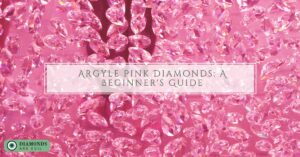To begin with, its important to understand how diamonds mined beneath the earth’s crust are made before explaining how lab-grown diamonds are formed.
How it’s made
Although the processes are quite similar, just that the former undergo a natural occurrence while the latter occurs in a lab. Geologists that mined diamonds accept as true that diamonds were formed deep within the Earth crust about 1 to 3 billion years ago. Despite not knowing how the diamonds came to be, they, however, conclude that diamonds are formed from buried carbon dioxide hundred miles beneath the surface of the earth.
Theoretical reports made on diamonds
- The findings made and issued by Diamond Foundry propose that the entire environmental footprint of lab diamonds is lesser when compared to mined diamonds. Extra energy is a requisite factor in extracting diamonds from beneath the earth than it takes to create one in the lab. The energy expended in mining is mostly dirty diesel against renewable energy in the energy used in producing diamonds in the lab.
- However, an approximate figure of 250 tons of earth is distorted for every single carat of diamond that is mined underground. In 2018, 148 million carats diamonds were mined. Without a doubt, some land spaces used for mining activities can be seen from space using the Nasas Terra digital equipment.
- Also, another report proposed by the consulting firm Frost and Sullivan in 2014 disclosed that diamonds that are mined underground require twice as much energy per carat than the diamonds grown in a lab. For individual single carat of diamond that is mined, 57kg of carbon is estimated to be released into the atmosphere. But lab-grown diamonds do barely release substantial kilograms of carbon into the atmosphere like the mined gems does; however, this report accepts that renewable energy is recycled, and some players in the industry have doubted the reliability of the report.
Adverse effects of mining
The environmental destruction experienced as a result of diamond mining is beyond the emission of carbon dioxides alone.
The process of mining diamonds has an effect on pollution of water bodies used by indigenous people due to acid mine drainages and it at several metal mines and coal mines. This happens when there is the streaming of minerals given off from mined rocks into the water body readily present around the mining region. This act has been described by a Canadian university, University of Waterloo “as one of the greatest adverse effects of mining activities”. Neither lab-created diamonds nor diamonds mined from the earth are perfect; the broader the environmental price of mined diamonds a result of few industries in the world having broader social and environmental footmarks than mining.
Another point to also consider is that, as opposed to diamonds mined from the earth, the demand for lab-created diamonds could make some people lose their jobs from developing countries that are resource-rich. In lieu of this, the quest to terminate mass atrocities in Africas deadliest war regions proffers an ethical way to discourage people from patronizing diamonds grown in the lab from developing countries where more than a million people rely on their jobs.
The uniqueness of lab-created diamonds
The chief executive officer of Ada Diamonds, Jason Payne by name debates that diamonds created in the lab significantly lowers the rate at of carbon footprints in transportation and communications. The quality of purity and hardness is an edging lab-created diamonds have over diamonds that are mined. Lab-created diamonds are found to be one thousand percent durable than mined diamonds. The state of a diamond being pure helps to lower friction in moving mechanical parts of vehicles. When a diamond film is used, it reduces friction by 40%. In contrast, mined diamonds lack the purity needed for many of these applications.
Mined diamonds simply do not fashion out processes for its creation but are formed beneath the earth from carbon dioxide, as asserted by geologists who mine them. Mined diamonds are formed in regions where there are high temperatures and pressures, and they can only be mined when there is an eruption of volcanoes. The eruption tends to bring the gems closer to the earth’s surface than they were miles way into the ground.
The same concept of High Pressure and High Temperature is adopted in the production of diamonds in the lab. But in explaining these two processes that can be adopted for its creation in the lab. One of the processes involves subjecting it to High Pressure and High Temperature (HPHT), while the other is the Chemical Vapor Deposition (CVD) method. In this method, a mix of gasses comprising of carbon is added at a pressure that is very low. Microwaves of increased intensity of heat are added to heat the combined gases and made to generate a plasma. Once the temperatures increase to over several thousand degrees, the molecules of the gas then break off, making some of the bonds to the diamond seeds with carbon atoms, thereby growing them in the layer. High Pressure, High-Temperature diamonds are produced by means of one of three manufacturing processes; cubic press, split-sphere press, and belt press process. All of these three processes generate an environment that is of extremely high pressure and temperature, which favors the growth of diamonds.
In conclusion
For every type of diamond, whether lab-grown or earth mined has a centrally agreed system of pricing. Their pricing system, as regards retail and wholesale, is based on an international level of acceptance, which is referred to as the Rapaport pricing method. This method of pricing diamonds is based on their 4Cs, which are; carat, color clarity, and cut grade systems.
It matters less if the diamond is earth mined or grown in the lab, either wholesale, retail or resale prices, all of these are determined centered on the Rapaport prices discount percentage regardless of where the diamond emanated from. Hence, both labs created diamonds and mined diamonds that have the same costs in terms of cutting, polishing, and inspection; however, if there is a slight deviation from the Rapaport pricing system, as regards the costs and processes leading up to that level, the substantial charge of mining.
In terms of appearance, both lab-grown diamonds and earth mined diamonds are real and very identical. These diamonds cannot be distinguished with an ordinary eye even by professional gemologists except with the use of specialized equipment. The lab-grown diamonds also possess the sparkle you will see in every other natural diamond. The easiest way to identify diamonds as either lab-created or not is to simply have a look at the grading report.
Finally, it is important to have the fact that both laboratory-grown diamonds and mined diamonds consist of pure(new) carbon in a cubic crystalline form, even though diamonds are manufactured in a lab, and those created by nature have but a few important differences. What strikingly sets them apart is the process they undergo before they are manufactured and a consistent ability to keep making much more of them even into the future. Another indisputable fact is that all the natural diamonds that will ever occur within the earth had already been formed by nature; however, lab-grown diamonds can always compensate for its depletion.






